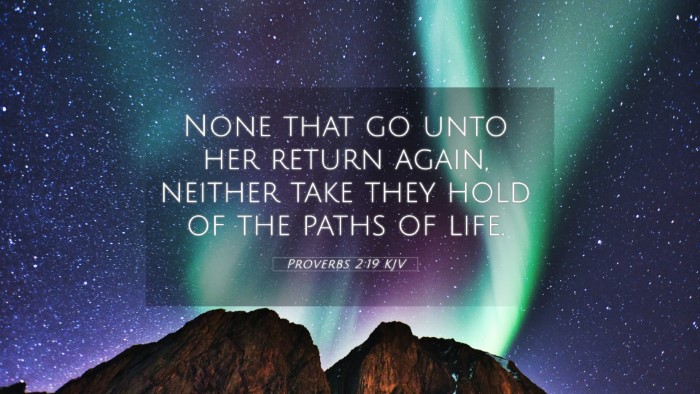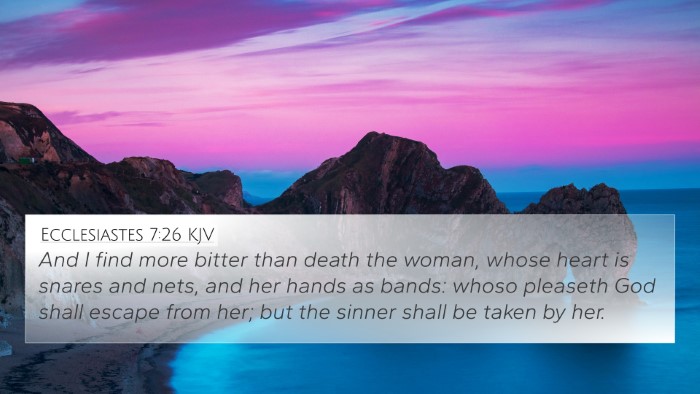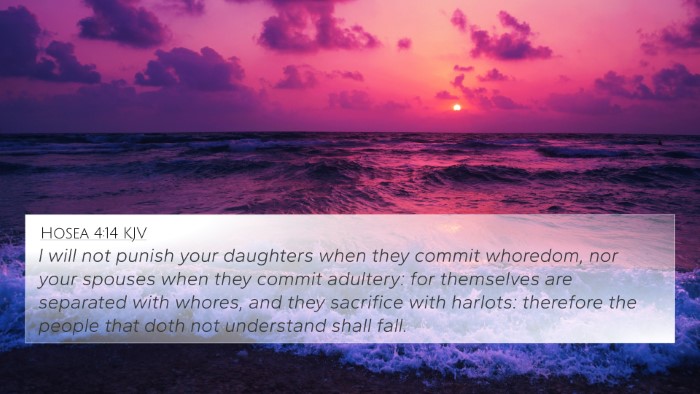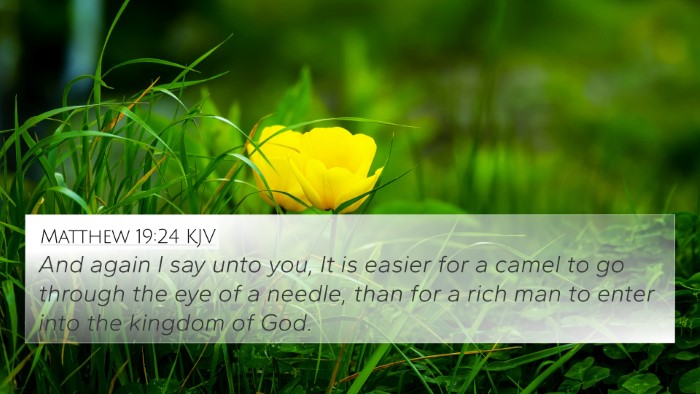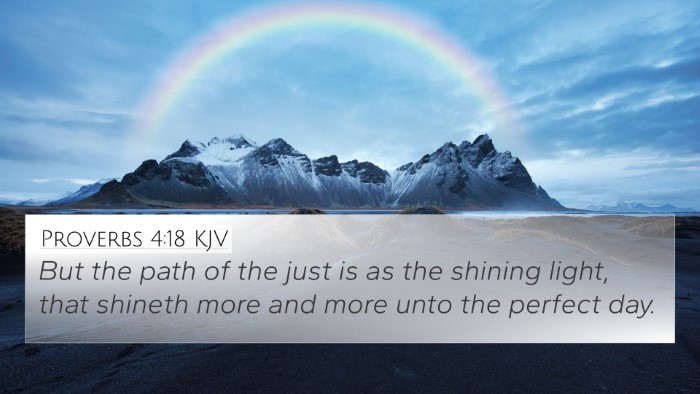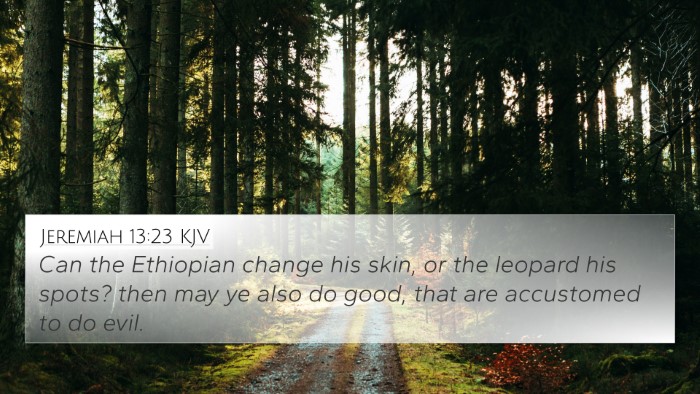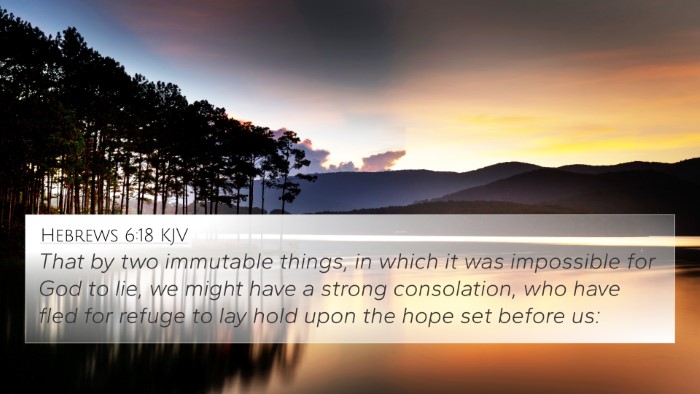Understanding Proverbs 2:19
Proverbs 2:19: "None that go unto her return again, neither take they hold of the paths of life."
Summary and Interpretation
Proverbs 2:19 presents a significant moral teaching about the consequences of following the path of wickedness, particularly through the metaphor of an unfaithful woman. The verse asserts that those who pursue such paths do not return to the way of life. Here’s a deeper exploration of its meaning based on insights from various public domain commentaries.
Insights from Matthew Henry
Matthew Henry emphasizes that the "her" in this verse symbolizes seduction and the allure of sin, suggesting that those who engage in wicked pursuits ultimately lose their way. He argues that such paths do not lead to fulfillment or happiness, reinforcing the necessity of choosing the path of wisdom and righteousness instead.
Insights from Adam Clarke
Adam Clarke points out that the verse serves as a dire warning about the inevitable consequences of straying from God's commandments. The imagery conveys that once individuals are ensnared by sinful temptations, they stray from the path of life, which is synonymous with spiritual fulfillment and eternal life.
Insights from Albert Barnes
Albert Barnes provides a theological context by relating this verse to the greater narrative of Proverbs, which contrasts wisdom with folly. He remarks that the "paths of life" represent the way of wisdom, and the expression "none that go unto her return again" means that engagements with sin can lead to irreversible consequences, highlighting the peril of unwise choices.
Connections with Other Scriptures
This verse can be cross-referenced with several other passages in the Bible that highlight the consequences of sin and the pursuit of wisdom:
- Proverbs 5:23: "He shall die without instruction; and in the greatness of his folly he shall go astray."
- James 1:15: "Then when lust hath conceived, it bringeth forth sin: and sin, when it is finished, bringeth forth death."
- Galatians 6:7: "Be not deceived; God is not mocked: for whatsoever a man soweth, that shall he also reap."
- Proverbs 14:12: "There is a way which seemeth right unto a man, but the end thereof are the ways of death."
- Romans 6:23: "For the wages of sin is death; but the gift of God is eternal life through Jesus Christ our Lord."
- Proverbs 1:32-33: "For the turning away of the simple shall slay them, and the prosperity of fools shall destroy them. But whoso hearkeneth unto me shall dwell safely, and shall be quiet from fear of evil."
- Ezekiel 18:30: "Therefore I will judge you, O house of Israel, every one according to his ways, saith the Lord God. Repent, and turn yourselves from all your offenses; so sin will not be your downfall."
Thematic Connections in Scripture
Proverbs 2:19 serves as a vital thematic connection within the Scriptures concerning the paths of life versus paths of destruction. It aligns with a plethora of other Bible verses reinforcing the idea that sin leads to death, while wisdom and obedience to God lead to life and peace.
Exploring the Themes of Wisdom and Folly
This verse forms part of the broader narrative in Proverbs where wisdom is often personified and contrasted sharply with folly. Notably:
- Proverbs 8:35: "For whoso findeth me findeth life, and shall obtain favour of the Lord."
- Proverbs 10:17: "He is in the way of life that keepeth instruction: but he that refuseth reproof erreth."
- Proverbs 12:28: "In the way of righteousness is life; and in the pathway thereof there is no death."
Cross-Referencing and Practical Application
For those studying the Bible, the practice of cross-referencing can deepen understanding of Proverbs 2:19. A solid Bible concordance or cross-reference guide can aid in this endeavor by highlighting connections between various scriptures. Understanding how different verses relate can clarify and enhance one’s spiritual comprehension.
How to Use Bible Cross-References Effectively
Developing skills in cross-referencing Biblical texts enables believers to uncover deeper meanings within the Scriptures. Here are some methods:
- Utilizing a Bible Concordance: Search terms or phrases in the concordance to find related verses.
- Employing a Cross-Reference Bible: These editions provide direct links to related passages, facilitating quick access to thematic connections.
- Studying with a Guide: Many different Bible study guides elaborate on themes and relationships between verses, which can enrich personal study or group discussions.
Conclusion
Proverbs 2:19 serves as a poignant reminder of the importance of choosing wisely between the paths of righteousness and unrighteousness. By engaging in a comparative Bible verse analysis using cross-referencing tools, one can better understand the broader context and implications of this scripture. Whether seeking to comprehend life choices, dangers of sin, or the need for wisdom, this verse—with its theological and practical ramifications—provides crucial insights for anyone on their spiritual journey.

